It makes you go blind
Synopsis: There is a sexual arms race between the queen and the drones she mates with. The queen needs to mate with multiple drones to maximise colony fitness. Conversely, it’s in the interest of individual drones to reduce the number of additional partners who mate with the queen. Recent studies have demonstrated that drones reduce repeat mating flights by impairing the eyesight of the queen. Potential implications of this for practical beekeeping are discussed.
Introduction
Honey bee queens are described as polyandrous {{1}} because they copulate with multiple drones during one or more mating flights taken shortly after emergence.
These multiple matings are a risky business {{2}}.
It takes longer to mate with multiple drones than it does to mate with one, but this time is minimised by reducing the number of mating flights. Rather than leaving the hive, mating once, returning and then repeating the process, the queen flies some distance to a drone congregation area and copulates with multiple drone before returning to the hive.
I’ve discussed the location and locating drone congregation areas previously and the distances the queens and drones respectively fly to reach these (which are different to avoid inbreeding).
Between the queen returning from the mating flight and the onset of egg laying there is a delay of a few days. During this period the queen is storing the sperm from the drones in her spermatheca. These are the sperm storage organs within which sperm stays active for years … a necessity as, after the onset of laying, the queen will not go on any more mating flights.
Perhaps surprisingly, only about 3-5% of the sperm transferred from each drone is stored by the queen.
I hope that makes you wonder why she bothers mating with so many drones … it should.
Polyandry and hyperpolyandry
Just before I explain why she only stores 3-5% of the sperm from each of several drones, rather than storing it all from one twentieth the number (and thereby reducing the risks of longer mating flights) of drones, I need to explain the poly bit of polyandry.
How many drones does the queen mate with?
The usual figures quoted are in the high teens, with a range extending from single digits into the low forties. These numbers are determined using a variety of different techniques, at least some of which are likely to underestimate the actual number of drones.
Think of it like this, if you have a large population of something – like beekeepers – how many would you have to ‘sample’ to find one called ’David’.
Not many, it’s a common name.
But what about ’Atlas’ or ’Zebedee’?
You’d have to sample a lot more apiarists to find any with these rarer names, though I bet they’re out there somewhere. You might even have to use a different way to screen the population.
And it’s the same when determining the numbers of drones that the queen mates with.
When you use a method that specifically looks for rare patrilines – essentially genetically distinct offspring fathered by different drones – you can find them. This suggests that the queen probably mates with more than the 15-19 drones usually quoted, and that hyperpolyandry is perhaps a better term to describe the mating behaviour of queen honey bees.
There’s evidence that these very rare patrilines (so-called ‘Royal patrilines’) are preferentially selected when rearing queens under the emergency response.
Colony fitness
So now we’ve defined what the poly in polyandry means … but we still don’t know why the queen risks all those aerial shenanigans to mate with so many different drones.
By mating with multiple drones she ensures that the workers in the colony are genetically diverse. This genetic diversity increases the rather-difficult-to-grasp concept of colony ‘fitness’. In this instance fitness is used to mean a combination of adaptability, resistance to stress or pathogens, increased foraging activity, better overwinter survival etc.
I’ve discussed this concept before and suggest you revisit that post for all the gory details.
The bottom line is that colonies that are headed by queens that are mated with very many drones (50+) produce more brood, have better disease resistance and have many other desirable traits (that benefit both the colony and the beekeeper).
The final piece of this introductory jigsaw I need to mention is that drone sperm is used randomly. It’s not a case of ‘first in, last out’. The 3-5% of sperm stored from each drone is mixed thoroughly in the spermatheca.
This makes sense in light of the comments above about colony fitness. If the sperm were used in batches from each drone you’d have cohorts of young bees being produced that had reduced genetic diversity, thereby potentially compromising colony fitness.
It takes two to tango
But let’s think about the poor drones for a moment.
Drones have two fates (excluding getting eaten by a bee eater); they either die while mating with a queen, or they get turfed out of the hive and starve to death towards the end of the season.
If the drone fails to mate with a queen he’s genetic dead end.
If he does mate with a queen there’s a good probability that the genes he carries will be passed on to the following generation.
There is therefore a lot of competition for the queen in the drone congregation areas (DCA).
The drones, once sexually mature, fly every (suitable) day to several DCAs, one after the other. In addition, they fly relatively short distances from the hive to maximise their time within the DCAs.
This competition is intense, and it doesn’t stop once the drone has mated (and died).
If a queen mates with a relatively small number of drones – let’s say 10 for the sake of argument – the chance of the sperm from any one of those drones being used to fertilise an egg is much greater than if the queen had mated with 50 drones.
The fewer drones the queen mates with the better the chances that the genes from any one of her successful suitors will be passed on to the following generation.
Paradoxically, it therefore benefits the drone {{3}}, if the queen mates with fewer other drones.
And, remarkably, drones have evolved a way to reduce the number of additional drones that a queen mates with.
A sexual arms race
Before I describe the mechanism, it’s worth emphasising here that best interests of the colony are served by the queen mating with many drones, but those of the drones are best achieved by limiting the polyandrous activity of the queen.
These two processes are therefore in direct competition.
There are some additional subtleties.
If the drone simply prevented the queen from mating again {{4}} it would be detrimental if that drone was the first with which the queen mated. The resulting colony would have little genetic resilience and would be unlikely to survive.
Any one drone must therefore allow the queen to mate with sufficient other drones to ensure colony fitness.
In addition, the more mating flights that a queen goes on, the greater the chances she will be predated by a passing bird, or get lost on the return flight.
From the drones point of view it would probably be beneficial for the queen to go on only one mating flight, but that she mates with sufficient (but no more than that) drones on that flight.
And finally, before I get to the mechanism by which all this is achieved – a compromise solution, like all the best solutions – I’ll remind you that studies have shown that queens go on about 5 mating flights spread over 3, usually successive, days.
Love is blind
At least, too much love is … 😉
Liberti and colleagues have recently published a snappily titled paper on how drones reduce the number of mating flights taken by a queen. The paper is Open Access so you can get all of the nitty-gritty details I don’t have time, energy or intelligence to include in the summary below.
The paper is:
Seminal fluid compromises visual perception in honeybee queens reducing their survival during additional mating flights by Joanito Liberti et al., (2019) eLife 2019;8:e45009
As with all science, the results published in this paper were a continuation of earlier studies of queen honey bees. In particular, these included studies by some of the same authors who had showed that seminal fluid contained proteins that had the ability to interact with neurons.
In addition, in Drosophila melanogaster (the fruit fly, and genetically best studied insect) there was evidence to suggest that seminal fluid promotes fast oviposition and reduces the willingness of females to seek additional copulations.
Now, Drosophila mating behaviour is very different to that of honey bees, but there was clearly a precedent here in which some of the components of seminal fluid – the ‘carrier’ that keeps sperm alive and motile and protects against pathogens – influenced subsequent mating in insects.
Or the lack of mating.
The study by Liberti et al., involves an elegant combination of hardcore molecular gene expression analysis coupled with electroretinography {{5}} and field work. I’ll skip briefly through the first two of these and provide a bit more detail on the last.
Analysis of gene expression
Virgin queen bees were instrumentally inseminated with seminal fluid (i.e. no sperm) or a control saline solution. Subsequent analysis of the brains of the bees – using a method called RNA-Seq which allows the qualitative and quantitative changes in gene expression to be accurately determined – demonstrated reproducible changes in the gene expression of dozens of genes.
Detailed analysis of which genes had changed in expression showed that several so-called signalling and metabolic cascades were modified in response to seminal fluid, and many of these mapped to the phototransduction pathways i.e. those involved in sight.
Several of the genes that were detected encoded proteins that were implicated in the conversion of light into the electrical signals in photosensitive electrical cells.
Inevitably, that one sentence has probably confused half the readers that have persevered to this point in the post …
Essentially what this means is that there are components within drone seminal fluid that change the ability of the queen to perceive light, or to see.
So, do they?
Visual perception of queens
The gene expression studies in this paper are complicated (for a molecular biologist). The electroretinography is an order of magnitude more complicated for this molecular biologist to understand … but here goes.
Electroretinography involves measuring the electrical signals generated by particular neurones that are connected to the compound eyes and ocelli {{6}}. This allows the consequences of the changes in gene expression to be determined in terms of the vision of the queen bee.
These studies showed that queens instrumentally inseminated with seminal fluid had lower responses to low frequency flickering light, and that that this response (or lack of response) increased on the second day after insemination.
There were additional changes in the response of the ocelli in queens inseminated with seminal fluid.
Taken together, these results show that queens exposed to seminal fluid experience reduced visual performance.
They are not blinded, but their vision is impaired.
Does this visual impairment have any influence on their mating behaviour?
Mating flight behaviour
Finally, we come to something that’s a bit easier to comprehend, not least because I’ve previously discussed the technology used – the RFID tagging of individual bees to monitor their flight frequency and duration.
RFID-tagged queens (34 in total) were instrumentally inseminated (either mock, or seminal fluid or semen) and subsequently monitored when going on mating flights. Those receiving either seminal fluid or semen were more likely to get lost on these flights, and repeatedly triggered the hive entrance sensors, suggesting they were disorientated by sunlight after leaving the hive.
Of the 21 queens that returned, 81% went on mating flights of more than 7 minutes which was considered a conservative threshold for a completed mating flight i.e. flight to a DCA, mating(s) and return to the hive, and about 50% laid worker brood.
Notably, of the 17 queens that went on ‘successful’ (by duration, not necessarily by outcome) mating flights, those receiving the control saline solution left 1-2 days later than those that had received seminal fluid or semen.
These results show that exposure to seminal fluid induces significant changes in queen mating flight behaviour, presumably as a consequence of the alteration to the vision of the queen.
Therefore, the implication from these results is that proteins in the seminal fluid of drones impairs the visual perception of queens, thereby reducing the likelihood that the queen will embark on additional mating flights.
Queens that had already mated (or been instrumentally inseminated in this study) were more likely to get lost on subsequent mating flights, and embarked on these flights earlier.
But what about swarming?
The hive – or a natural nest site – is a low-luminance environment. Queens do not need fully functional eyesight once they have returned from their mating flights. In the hive communication is non-visual, mediated by pheromones, contact, vibrations and sound.
However, although a queen only goes on a few mating flights, she will also leave the colony if it swarms.
What are the implications for the this study on the eyesight of queens during swarming?
This isn’t really discussed in the paper, but I think there are two likely scenarios:
- the changes in visual perception by the queen are transient and return to ‘normal’ after a few days, weeks or months
- swarming is a fundamentally different activity in which thousand of bees leave the hive and for which accurate vision is not needed by the queen.
There’s a world of difference between embarking alone on a mating flight of several kilometres and having to return to the exactly the same location, and leaving on a one-way trip with a swirling mass of attendees with dozens of scout bees leading the way.
Further studies will be needed to determine whether the changes in vision are transient or permanent, as well as to identify the ‘active ingredient’ in seminal fluid that is responsible for the degradation of the mated queen’s vision.
I also think further studies will be required to determine the relationship between dose and timing of the response.
How long does it take for the reduction in visual perception? If the first and second mating flight are taken on successive days is the “return rate” greater than if they are taken a few days apart?
How many drone matings are needed to reduce the visual acuity of the queen? I would predict that this would be a number consistent with the lower estimates of polyandrous matings needed to generate fitness in the resulting colony.
And implications for practical beekeeping?
Perhaps none directly, though I’m interested in the answers to the questions I posed in the paragraphs above.
In an area with low drone densities and those with shall we say ‘variable’ weather – such as my apiaries on the west coast of Scotland (or for that matter, any beekeepers living in remote northerly areas with just a few hives) – is colony fitness compromised by reduced matings?
Conversely, is mating success lower because more queens fail to return from subsequent mating flights that they have to take to try and mate with enough drones?
Can mating success and colony fitness be increased by boosting drone numbers?
And is this achievable at a scale meaningful to a small-scale beekeeper?
If a measurable increase in mating success took a 1000-fold increase in drone numbers it’s probably not achievable.
However, if all it took was an extra frame of drone comb in every hive in the apiary, then that’s quick win.
{{1}}: Derived from the Greek πολύανδρος meaning ’having many husbands’.
{{2}}: And I’m ignoring all of the sexually transmitted diseases that they might acquire … Ewwww!
{{3}}: Or, more correctly, the genes carried by the drone.
{{4}}: The ’put a cork in it’ strategy … and there are examples of this in other species.
{{5}}: WTF?
{{6}}: I’ve not written much previously on the eyesight of bees – the compound eyes are big and obvious, the ocelli – there are three of them – are on the top of the head and can be considered as simple eyes that can discriminate between light and dark and are used to orientate the bee towards the sun.
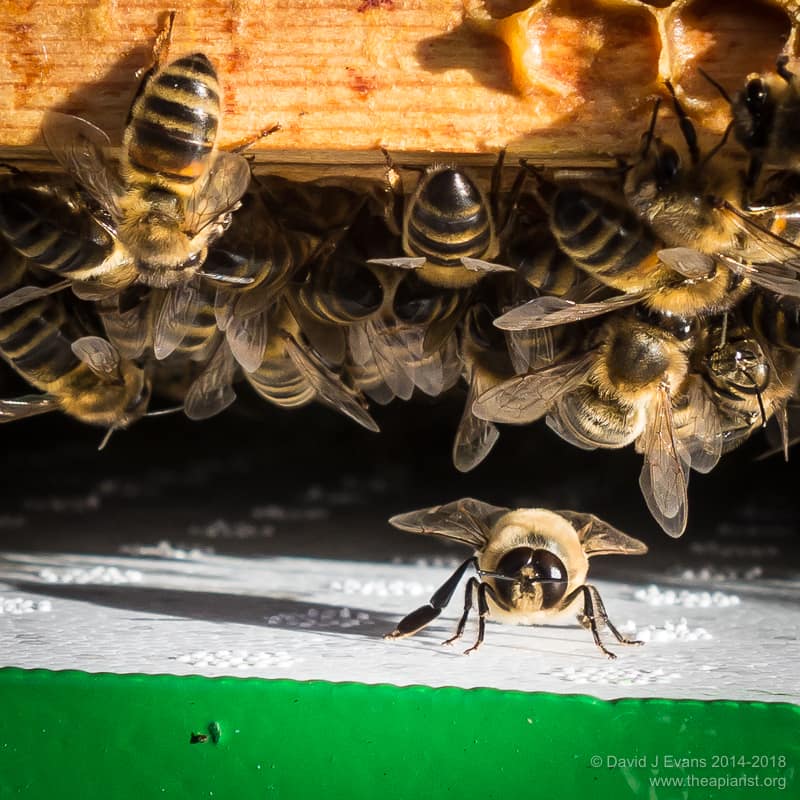
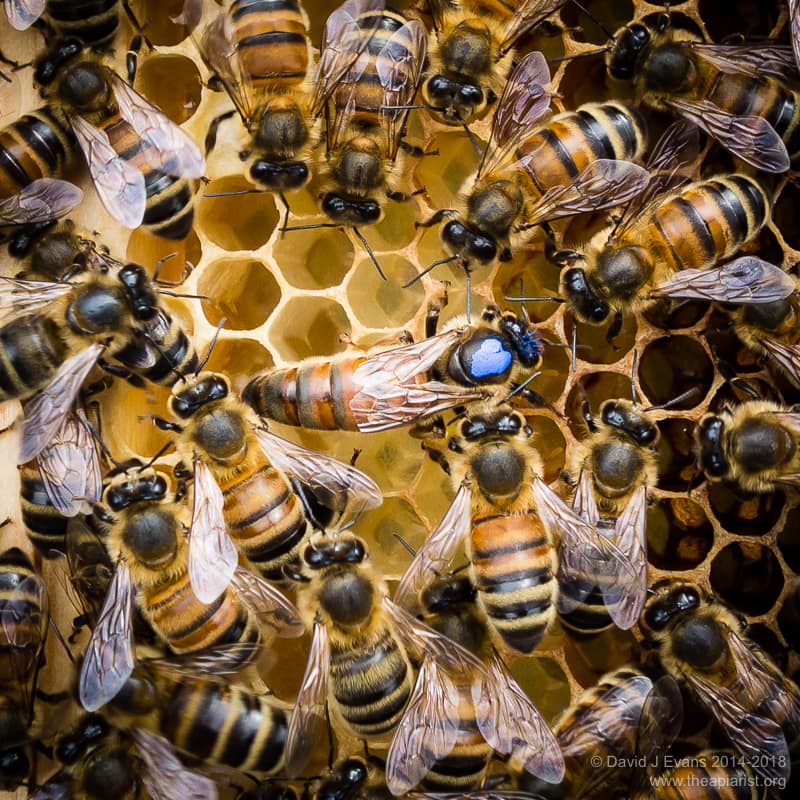

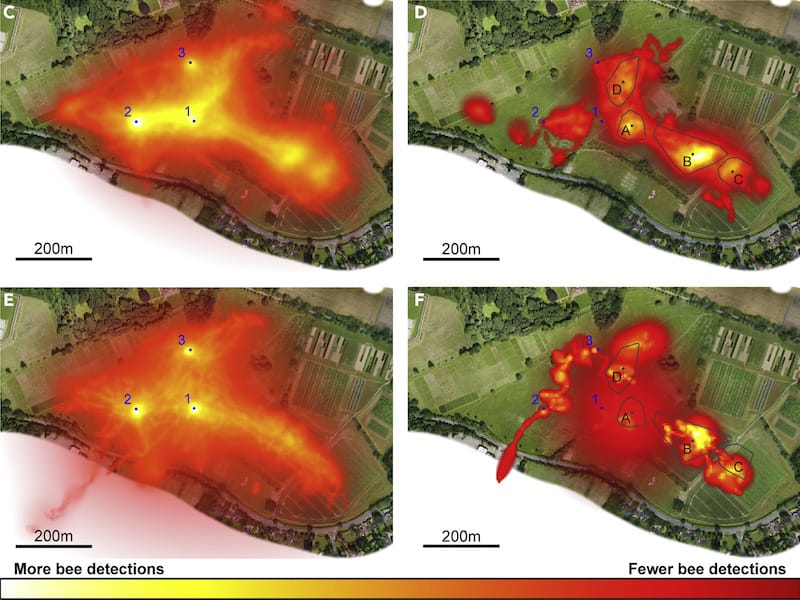
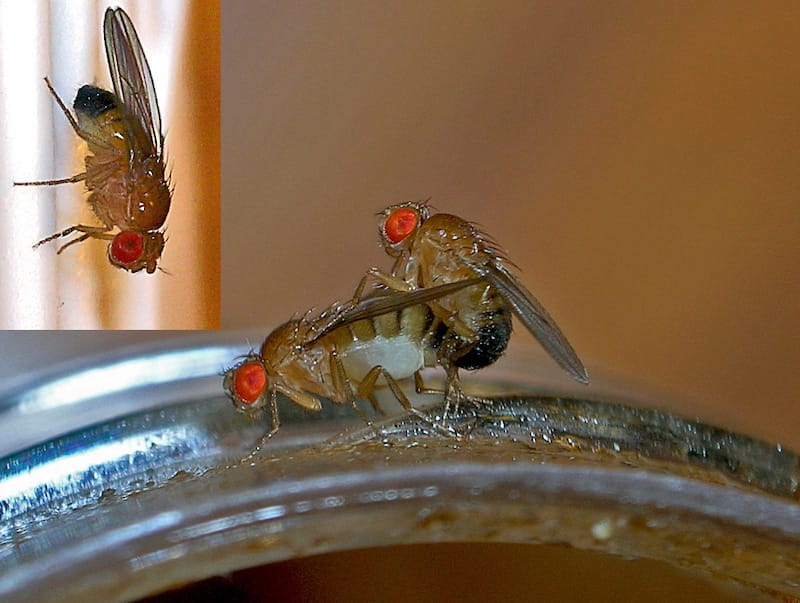
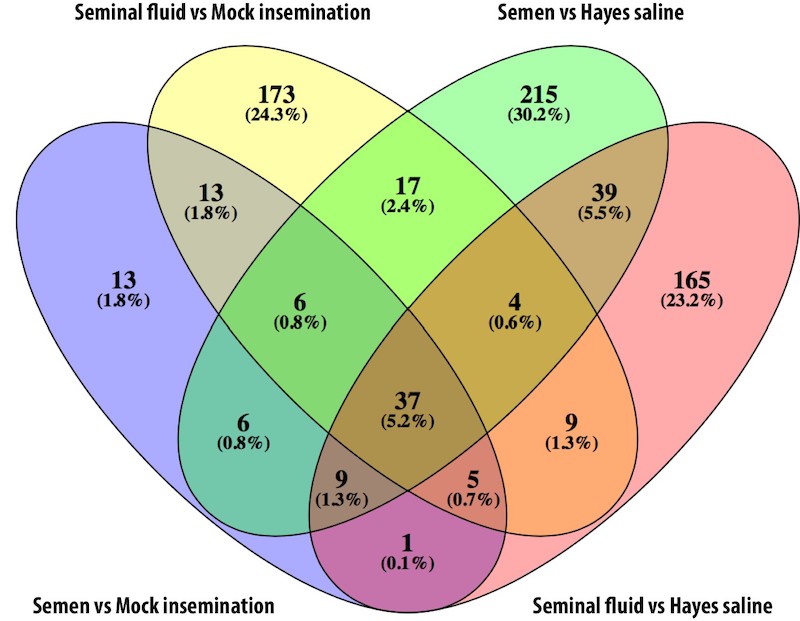

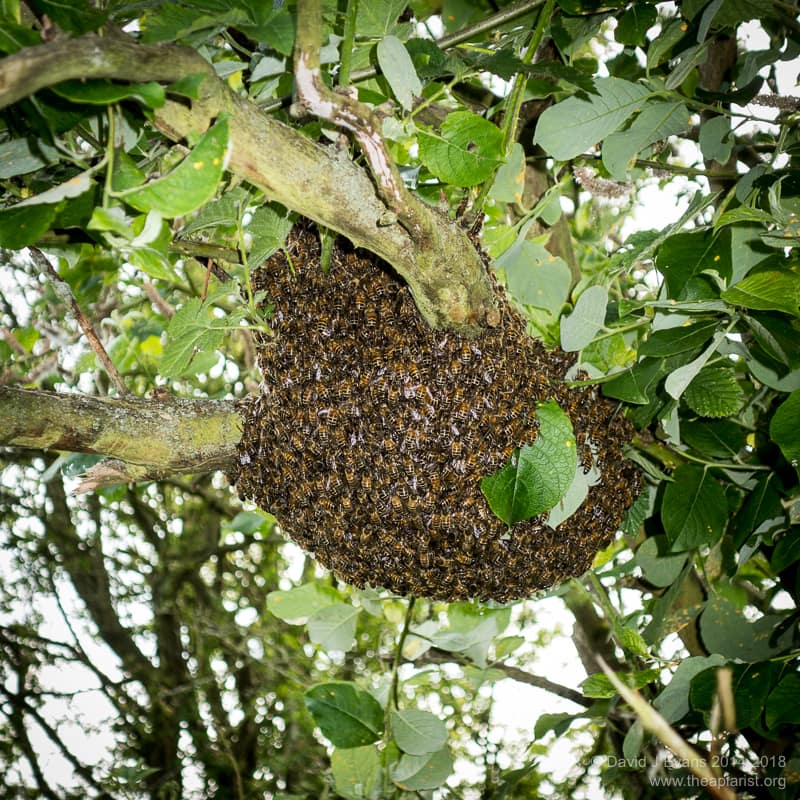
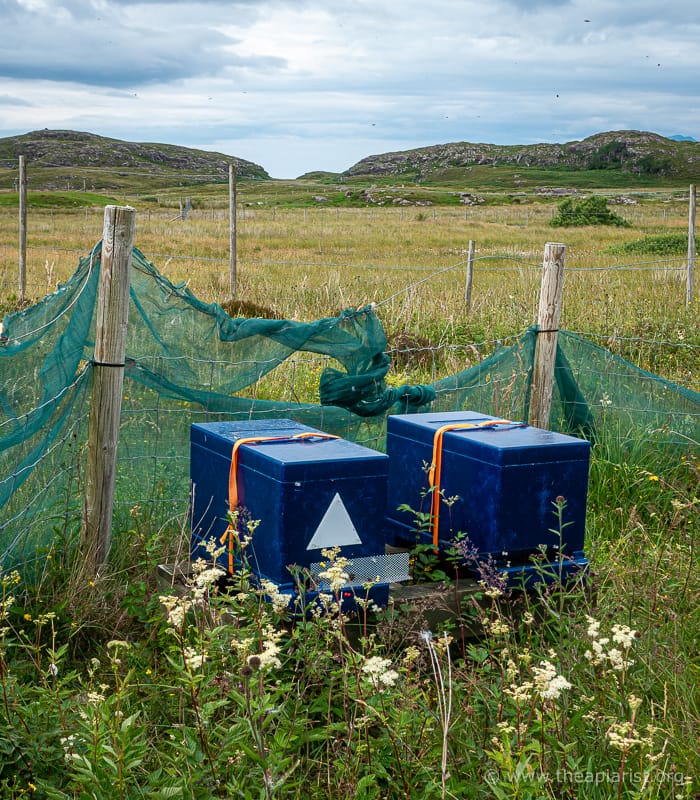
Join the discussion ...